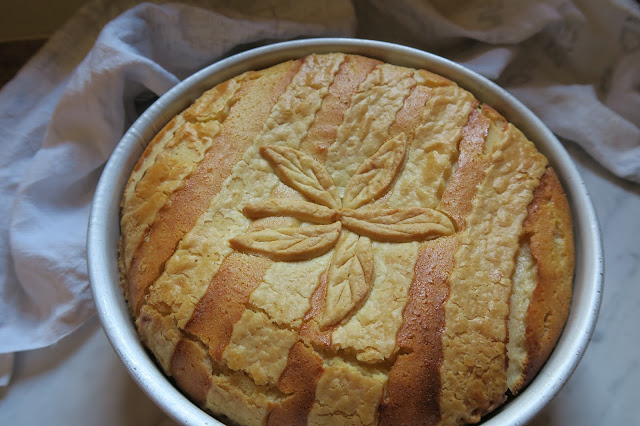Easter and its traditional foods make many references to the rebirth, not just of Christ through his resurrection, but also through continuing traditions from pre-Christian times.
One major symbol still quite evident from the pre-Christian springtime rites and linked to Easter is wheat. It was a widespread custom in Italy to sprout some wheat berries in a dark corner of a room at the beginning of Lent. My maternal grandmother still continued this tradition in Australia and would make its offering to the alter on Holy Thursday. These would decorate the Easter Sunday alter at the Italian mass of her parish church.
As a child I remember the days leading up to Easter were always solemn and not much in terms of activities nor chores were undertaken. We weren't allowed to turn on the radio or TV, it was a time of pray and reflection. So to help break the gloomy atmosphere for us children, sweets were prepared in advance. My grandmother would make i canestrini - little baskets with an egg in the centre and the dove made from sweet pastry. When my mother was growing up, receiving a chocolate egg was quite rare, so my grandmother would create these sweets instead as gifts.
La Pastiera Napoletana is a classic Neapolitan pastry of sweet crust filled with ricotta, pastry cream, cooked wheat berries and scented with orange flower water. My mother has modified this original recipe to suit my fathers simple tastes, only leaving the ricotta, eggs, vanilla, and of course the sugar with lots of cinnamon as part of the filling. I have decided to bring back La Pastiera Napoletana to the family and hope my father will like it. Though I am certain my mother will have a back up plan and have made one specially for him! There are many variations, but this one which I have adopted from two other recipes appears to come close to what I think will delight.
White wheat berries without the husk are best used and Italian grocery stores will always sell it around Easter time. If no wheat berries are available, they can be substituted with an equal amount of short grain rice (boil it like pasta until tender, about 15 minutes), or pearl barley, cooking it exactly like the wheat berries. I have gone with the pearl barley as it is what I had in my pantry.
Pastiera Napoletana (Neapolitan Wheat Pie)
Pastry:
- 2 cups flour
- 1/3 cup castor sugar
- 1/2 teaspoon
baking powder
- 1 stick (125 grams) unsalted butter,
cold, cut into pieces
- 2 eggs
Filling:
- 100 grams white wheat berries or pearl barley
- 3 whole eggs
- 1 egg yolk
- 1 cup castor sugar
- 1 tablespoon of flour
- 1 cup
milk
- 350 grams ricotta
- 1 teaspoon orange flower water
- 1/3 cup
candied orange peel, cut into small pieces
- 1 teaspoon ground cinnamon
Rinse and soak the wheat berries or pearl barley in cold water overnight and cook them the next day in a large saucepan with 4 cups of water over a medium heat; decrease the heat to low and simmer until cooked through for about 1 hour. Drain and allow to cool.
Meanwhile, for the dough, pulse the dry
ingredients in a food processor. Add the butter; pulse until the butter is
worked in. Add the eggs; pulse until the dough forms a ball.
Divide the dough
into 2 pieces, one slightly larger than the other. Roll the larger piece on a
floured surface; fit into 9-inch (23 centimeter) greased tin. Trim dough even with the edge of the
pan. Roll the remaining dough to a 10-inch square; slide it onto a cookie sheet;
refrigerate.
Set a rack in the lowest level of the oven; pre-heat oven to 180 degrees celsius.
For the filling, whisk 1 of the eggs and the yolk
together in a bowl; whisk in 1/2 cup of the sugar and the
flour. Whisk in the milk; scrape the mixture into a small saucepan. Place over
medium-low heat; cook stirring until it comes to a gentle boil. Pour into a bowl and allow to cool. Whisk in the ricotta until smooth. Whisk
in remaining 1/2 a cup of sugar and the remaining 2 eggs,
one at a time. Stir in the orange flower water, orange peel and the cooked wheat berries.
Pour filling into the crust and sprinkle with
cinnamon. Brush the edge of the crust with water.
Cut the chilled dough into 3/4-inch
wide strips with a pastry cutter. Arrange 5 strips parallel and equidistant
from each other over the filling, letting the excess hang over the edge. Place
the 5 remaining strips at a 45-degree angle over first ones (this is optional). Press the ends of
the strips to adhere to the edge of the crust; cut off excess dough. You can also create a pastry decoration of choice and add it in the centre like I have.
Bake the pastiera until
the filling is set, puffed and the crust is golden, for about 1 hour.
Allow to cool completely inside the pan before removing. Dust with powdered sugar before serving.
Wishing you all a peaceful & happy Easter.








Comments
Post a Comment